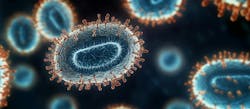The Baum laboratory along with colleagues at Imperial College London, UK, previously identified a new class of potent antimalarial compounds, belonging to a family of sulphonamides. These compounds kill the parasite only when it is in a specific sexual phase of its life cycle, rapidly stopping it from being able to infect a mosquito and, therefore, preventing any subsequent human infection.
In their new Disease Models & Mechanisms article, Baum and colleagues explored exactly how these compounds work, which is an essential step before the compounds can be developed for testing in patients.
The team began by growing human red blood cells infected with the malaria parasite in the lab, then manipulated the parasites to enter their sexual life stage. The scientists then treated these parasites with one of the sulphonamide compounds to find out which parasite proteins were being targeted by the transmission-blocking compounds. To do so, the scientists applied ‘click chemistry’, an approach that won the 2022 Nobel Prize in Chemistry to attach a chemical label to the sulphonamide compounds. This label would then tag any parasite proteins that came in contact with them. This technique identified a parasitic protein called Pfs16 as forming the strongest bond with drug. Interestingly, Pfs16 is important for sexual conversion of the malaria parasite. The team then performed additional experiments to confirm that the sulphonamides bind Pfs16 and, importantly, block its function.
The authors found that the sulphonamide compounds specifically targeted male parasites and uniquely inhibited their sexual maturation if administered to the parasite within the first 6 minutes of the sexual maturation process, which is the same time that the parasitic protein target, Pfs16, plays an important role in blocking male parasite maturation.
Overall, Baum and colleagues have identified how this new class of antimalarials block the parasite reaching sexual maturity, and therefore, their spread from human to human via a mosquito bite.





